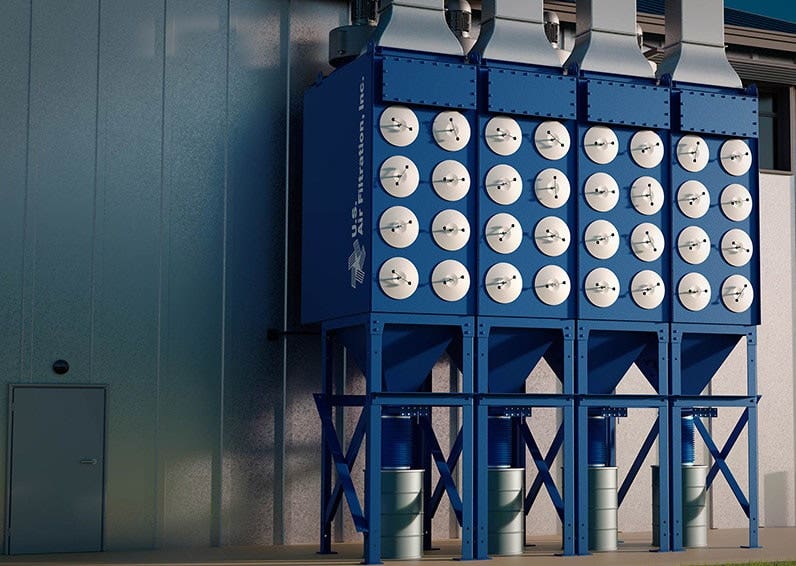Dust Collection Can Velocity
When considering the right dust collection solution for your facility, we’ve previously mentioned 5 factors that need to be considered:
- Dust Properties - Learn the dust properties you need to be aware of to help you find the right filter media and type of dust collector.
- Volume – Understand key variables for measuring volume or airflow requirements in your work environment in order to size your collector properly.
- Air-to-Cloth Ratio - Learn why air to cloth ratio is important and how to find the right air-to-cloth ratio for your operation.
- Dust Collector Styles - Learn about three most common dust collectors, their advantages and disadvantages.
- Low Maintenance Design Features - Learn important dust collector design features that will help you save time and money in long term maintenance expenses.
When sizing a new dust collector, these factors, along with understanding the importance of can velocity, will allow you to avoid unnecessary difficulties that would prevent your system from performing at peak efficiency.

What is Can Velocity in a Dust Collection System?
Can velocity is the speed at which air moves from low in the baghouse to high. The higher the can velocity, the faster air moves up in the system. The right can velocity for your dust collection system will be based upon your application and the density of your product. At US Air Filtration our engineers calculate your can velocity based on a few different factors.
The different dust characteristics and operating factors that help us understand can velocity are:
- Particle size
- Bulk Density
- Agglomerating/non-agglomerating (stickiness of the material)
- Loading rates

How to Calculate Can Velocity for a Dust Collector
In simple terms, the calculation is based on the area of the bottom of your dust collector’s filter bags. For example, if you have a dust collection system with 200 filter bags the calculation is the following:

Graphic Above: Dust collector housing ➖ area of the round bottom of the bags (qty 200) ➗ divided by volume
Impacts of Improper Can Velocity in a Dust Collection System
Low Can Velocity
- Low can velocity can lower air speed. If left for an extended period of time, dust can begin to accumulate inside your duct work. This build-up of dust work can cause a decrease in airflow or suction at your pick-up points, thereby resulting in an insufficient performing dust collection system.
High Can Velocity
- High can velocity can cause higher differential pressure and an increase in cleaning cycles of the pulse-jet cleaning system. This can result in filter bag abrasion caused by too much airflow through the dust collector housing and increased energy costs.
- A dust collection system with a high can velocity may filter as you expect at first, but as time goes on, dust will continue to cover the filter bags. The dust collection system will not be able to drop the dust off the bag, therefore the permeability per bag will decrease, and you will lose airflow.
How To Solve High Can Velocity
Solving for an excessively high can velocity can be tricky. We recommend working with a U.S. Air Filtration engineer to help determine what the right solution would be for your particular problem and dust collection needs. In general, some of the solutions can include:
- Increasing the size of your dust collector
- Reducing the airflow.
- Lowering your volume
- Possibly a baghouse conversion, but in certain cases this may only lower your air to cloth and not remedy a high can velocity
- Inlet placement
Summary
Industrial dust collection suppliers generally quote systems based on air to cloth ratios, but it’s important to keep in mind that air to cloth ratio and can velocity are related. Can velocity is a variable to consider depending on what type of material you have. For example, if your application includes very light material, we recommend paying close attention to the quotes you're receiving. If one potential supplier has quoted you with a low inlet, high can velocity, and a price that is significantly less, then that dust collection system will have higher differential pressure, an increase in cleaning cycles, too much airflow through the dust collector housing causing filter abrasion, and ultimately be unable to perform as it was intended to.
Considering all the components involved in choosing the right dust collection system can be an overwhelming process. While it’s important to understand the impact of can velocity on both performance and price, our ultimate goal at U.S. Air FIltration is to provide you with the full service of designing and engineering the right dust collection system that will meet your specific needs and requirements. When you work with U.S. Air Filtration engineers for your next dust collection project, they will ensure you have the right air to cloth ratio and can velocity that will allow your system to perform safely, efficiently, and reliably for many years to come.
If you’re just getting started, you can request a free project consultation with a dust collector equipment engineer here. Get assistance with can velocity, CFM, volume, filter media, design spec recommendations, and more.







